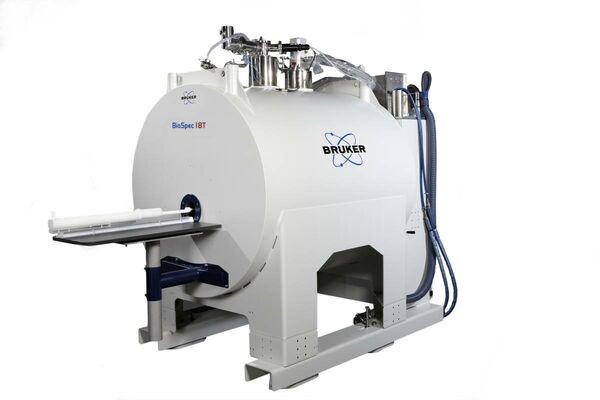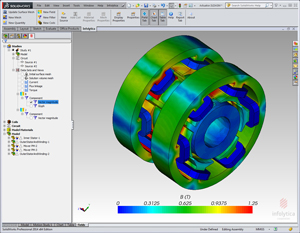
Bruker, a leading manufacturer of magnetic resonance imaging equipment, is working on the development of a powerful new system for the biomedical industry designed to advance the use of MRI equipment in oncology and neuroscience research. It would become the world’s highest field preclinical MRI system and uses the company’s proven Ultrashielded Refrigerated (USR) magnet technology.
The project is to develop the first horizontal 18 Tesla 11 cm bore, preclinical ultra-high field MRI system and its translational research applications in collaboration with the Champalimaud Foundation, a cancer and neurological sciences research lab in Lisbon, Portugal.
The system is expected to enable Champalimaud researchers to advance translational cancer and neuroscience research with ultra-high frequency MRI and magnetic resonance spectroscopic imaging. The project was jointly announced by the two organizations at the annual meeting of the International Society for Magnetic Resonance in Medicine (ISMRM) held this spring in Montreal.
Based upon Bruker’s BioSpec series (shown in photo), the 18T MRI will use the company’s superconducting zero boil-off USR magnet technology to extend the range of horizontal bore MRI at ultra-high field strength beyond what is currently available today from any manufacturer. The Biospec systems are designed for the emerging market of preclinical and molecular MR imaging and MRI research. Bruker’s MRI CryoProbe technology combined with ultra-high field USR magnets provide high spatial resolution in-vivo, thus enabling users to come closer to the molecular and cellular level research they desire. Its innovative modular design and a complete portfolio of application optimized RF coils enable a wide variety of MR imaging application in life science, biomedical and preclinical research.
With the USR technology, the magnets provide strong active shielding of the external magnetic field. This is achieved by use of a second superconducting coil which compensates the magnetic field outside the magnet. This drastically reduces the stray field to close to the magnet and thus strongly reduces the magnetic field to which the operator is exposed. All Bruker USR magnets include refrigeration technology for net zero boil-off of helium and maximum maintenance intervals.
According to Bruker, USR magnets utilize the latest pulse tube cryo-cooler technology to improve cryogenic efficiency and at the same time minimize the transfer of unwanted vibration to the magnet system. This is essential in order to achieve optimum artefact-free performance without the vibration related problems associated with other active refrigeration methods. This is possible because pulse tube coolers are far superior to earlier technologies in that they do not employ moving pistons and therefore minimize mechanical vibrations of the cold components.
Other features include compact ergonomic design, and nitrogen-free low maintenance operation. They exhibit a very compact shape and due to advanced coil design and elimination of the nitrogen vessel, are considerably smaller than conventional magnets of the same field strength and bore size. They are extremely robust and designed to be shipped cold. This results in huge savings in both time and expense when installing and commissioning the system.
Plans call for the new system to be installed at Champalimaud in late 2021 in the Neuroplasticity and Neural Activity laboratory under Dr. Noam Shemesh. The goal there is to develop novel contrast mechanisms in MRI and spectroscopic imaging. The foundation focuses its research on neuroscience and oncology, and the 18T system will advance the foundation’s in vivo research into cancer, metastasis and pre-metastatic niches in multiple cancer models. It will also advance research into brain plasticity and activity in normal and neurodegenerative disease models.
The foundation’s objective is to improve clinical outcomes. The preclinical 18T MRI will facilitate the discovery of new spatially resolved contrast mechanisms for elucidating biological function, and it will enhance temporal resolution to access additional information on brain dynamics.
“We are very excited to explore the full potential of the 18T MRI system, and to advance our understanding of biological mechanisms underlying healthy and diseased conditions,” commented Dr. Shemesh, principal investigator at Champalimaud. “We intend to harness the 18T ultra-high field and enhanced sensitivity to facilitate investigations into microstructure and metabolism dynamics in the brain, as well as in cancer, highlighting MRI as a tool for answering fundamental questions in biology, and not ‘just’ as a powerful diagnostic tool. We have a well-established, long-lasting collaboration with Bruker, and we are fully confident in the new science that will emerge from this project.”
Dr. Wulf-Ingo Jung, president of Bruker’s Preclinical Imaging Division, added: “We are extremely pleased to partner with the Champalimaud Foundation to collaborate on unique, enabling research tools to advance scientific research in both neuroscience and oncology. This exciting UHF MRI partnership will be a demonstration of what can be achieved in collaboration with a leading medical research institution.”
For more information, see https://m.fchampalimaud.org/en/champalimaud-research/ and www.bruker.com/products/mr/preclinical-mri.



